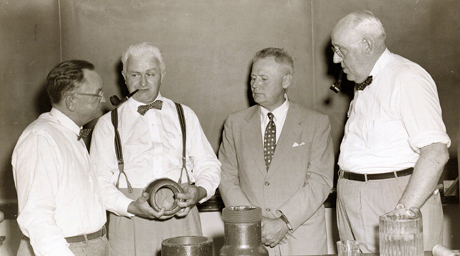|

|
|
|
Photo
of the Month |

Harry George Schurecht, second from right, spent his professional career researching ceramic clays and their application to industrial uses, in university, government and finally corporate settings. In the process, he secured some 15 patents, authored scores of technical papers and gave presentations at many conferences and seminars, making important contributions to science and technology. His work especially was valued during the World War II years as ceramic-wrapped spark plugs were used in the hurry-up production of military vehicle engines being deployed to the European and Pacific Theatres.
Harry and his wife, Caroline (Beggs) Perry Schurecht, made their home in many U.S. cities over the years as his work led him to a number of new employment opportunities. Their homes included in Washington, PA and Pittsburgh, PA; Columbus, OH; Washington, DC; Rahway, NJ; Alfred, NY; and finally Detroit, MI. His employers over the years included the Federal Bureau of Standards, the New York State College of Ceramics at Alfred University, and Champion Spark Plug. While at the ceramics college in New York in 1936, based on the reputation he had built in Washington, he became the initial director of the Ceramic Experiment Station, founded at the request of Dean M.E. Holmes, supported by the Ceramic Association of New York. In this role, he authored some 89 monthly abstracts from July 1936 through November 1943 summarizing the station's work.
Here, Harry consults with fellow researchers, left to right: John McMahon, his assistant at the college, recruited from the Canadian Bureau of Mines; J.O. Everhart of Ohio State University; and W.E. Robinson of the Robinson Clay Product. They appear to be discussing ceramic piping or containers of some sort, but the specific context behind this image seem to be lost to history.
We are grateful to the Scholes Library of the College Archives, NYSCC at Alfred University, where Harry worked from 1936 to 1942, for so graciously providing this image.
|
VisitPittsburgh.com is the promotional sponsor of this page |
|
Copyright © 2010 Mark A. Miner |